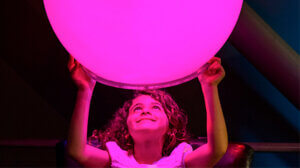I think everyone can agree that lighting affects their mood, even if only slightly. Maybe you dim the lights for a dinner date or have that special lamp in your office. You’re not sure why but you turn it on every time you really need to focus and get things done. It always seems to work. Certain colors make you feel energetic while others help to relax you. Lighting and color play a particularly big part in the mood and productivity of humans. Lighting has been shown to affect cognitive function through the disruption or improvement of our circadian rhythms. Light has been shown to even decrease depression scores when used strategically and even improve cognitive functions such as reaction time. Though not much empirical evidence has been found, the relationship between light and humans is undeniable.
Hostility and Arousal
A study performed at the Edinburgh College of the Arts aimed to find the relationship between lighting and mood. Specifically they tested out hostility, anxiety, and arousal in males and females when subjected to different color temperatures and lighting hues. The nature of the lighting effects is complex and is best summarised as initial effects and longer-term effects and Initial effects link illuminance with sensation seeking and correlated colour temperature (ccr) with hostility. They found that females became more relaxed and/or aroused when placed in warmer lighting environments. Men and women became more hostile while in cooler lighting environments. Ever noticed that your date is way more likely to stay over when the lights are dimmed and the candles are lit? Maybe this is why!
Circadian Rhythm and Our Limbic System
Think of Circadian Rhythm as our internal clock, naturally telling our bodies to go to sleep when the sun goes down and to wake up and feel productive when the sun rises. Unfortunately, in a world filled with technology and late night bars, this system can easily be affected and surprisingly has a huge affect on our bodies, both physically and mentally.
Blue light (Such as that given off by your flat screen or phone) suppresses our natural levels of melatonin. Yep! That means that hardly anyone in 2022 gets the naturally correct amount of melatonin and we’re all sleep deprived! Lucky us! Circadian rhythms can also affect the limbic system. This system regulates a person’s feelings of happiness, sadness, anger and other emotions. A disrupted rhythm can negatively affect these emotions and more. It’s important to counterbalance our reliance on blue light technology with healthy habits such as getting enough natural sunlight and trying not to sleep the day away, putting technology down when getting ready for bed, and exercise!
Impact of Color
Hue and Saturation both refer to the color and color intensity of a lightsource. We’ve all heard that different colors (Specifically when painting a home) can affect mood. For example, it is said that yellow relaxes you while blue increases your appetite. The same goes for the coloring of your light sources. Below is a list of how each color can impact your mood.
BLACK: In lighting and interior design, black can be used to portray authority, power, strength, evil, intelligence, thinning/slimming, death or mourning, elegance, formality, mystery, fear, prestigious and aggressive.
GREEN: Also known as the “strength provider,” green is the color of nature. Green light therapy stimulates the creation of growth hormones and strengthens muscles, bones and other tissues. It can also boost your immune system. In lighting and interior design, green can be used to portray nature, growth, cool, money, health, envy, tranquility, harmony, calmness, fertility, safety and ambition.
BLUE: Also known as the “bringer of peace,” blue can be used to lower high blood pressure or to calm people down. It’s also used for light therapies for people who have circadian rhythm disorders. In lighting and interior design, blue can be used to portray trust, loyalty, wisdom, confidence, intelligence, faith, truth, sincerity, cleanliness, air, sky, water, health, tranquility
PURPLE: Purple light can help reduce emotional and mental stress. Lighting and interior design projects can implement purple to portray royalty, power, nobility, luxury, ambition, wisdom, dignity, independence, creativity, mystery, magic and romance.
RED: In lighting and interior design, red can be used to portray love, romance, gentle, warm, comfort, energy, excitement, intensity, life, passion, danger, leadership, courage and friendship.
ORANGE: Also known as the “source of creativity,” orange stimulates the creative thought process and can help people come up with new ideas. In lighting and interior design, orange can be used to portray happiness, energy, enthusiasm, warmth, wealth, prosperity, sophistication, change and stimulation.
YELLOW: Yellow can sometimes be beneficial in the treatment for depression. In lighting and interior design, yellow can be used to portray happiness, laughter, cheer, warmth, optimism, hunger, intensity, frustration, anger, attention-getting, caution, sickness, jealousy, intellect and energy.
WHITE: In lighting and interior design, white can be used to portray purity, innocence, cleanliness, sense of space, neutrality, safety, beginning, faith and coolness
Seasonal Affective Disorder
Yep! As if we didn’t have enough to worry about… Not getting enough sunlight and the general gloom of fall and winter can actual cause disordered thinking. Many people, even those never previously diagnosed with a psychiatric condition, can feel extreme symptoms of depression and anxiety, especially during the winter. Light therapy is a common treatment method for SAD. There are many types of light boxes that can be utilized, but essentially, you are exposed to a bright light within the first hour of waking up every day. Its purpose is to mimic natural light outside, and studies have shown that it can cause a change in the brain’s chemicals, thus impacting moods.
So don’t worry! It’s not just in your head that you get happier every time you turn on your favorite lamp. Humans are designed to have a preference for light! It’s time we capitalized on this knowledge and finally take control of our lighting!
Based on these findings, you would think that lighting would be one of the main components people worry about when wiring or decorating a new home, but unfortunately it usually is not. If lighting is proved to be one of the largest components affecting mood and performance, why continue to sell yourself short? Maybe it’s time to take control of your lighting with an in home system that is completely unique to you. Visit our website to learn how we use Ketra and DMF products to completely customize an in-home lighting system to suit your needs.




